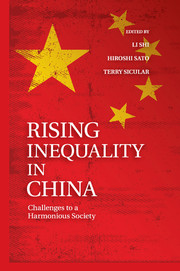Book contents
- Frontmatter
- Contents
- List of Tables
- List of Figures
- Contributors
- Preface
- Abbreviations
- Glossary
- 1 Rising Inequality in China
- 2 Overview
- 3 Housing Ownership, Incomes, and Inequality in China, 2002–2007
- 4 Educational Inequality in China
- 5 Inequality and Poverty in Rural China
- 6 The Evolution of the Migrant Labor Market in China, 2002–2007
- 7 A New Episode of Increased Urban Income Inequality in China
- 8 Unemployment and the Rising Number of Nonworkers in Urban China
- 9 Do Employees in the Public Sector Still Enjoy Earnings Advantages?
- 10 Redistributive Impacts of the Personal Income Tax in Urban China
- 11 Changes in the Gender-Wage Gap in Urban China, 1995–2007
- 12 Intertemporal Changes in Ethnic Urban Earnings Disparities in China
- Appendix I The 2007 Household Surveys
- Appendix II The 2002 and 2007 CHIP Surveys
- Index
- References
5 - Inequality and Poverty in Rural China
Published online by Cambridge University Press: 05 July 2013
- Frontmatter
- Contents
- List of Tables
- List of Figures
- Contributors
- Preface
- Abbreviations
- Glossary
- 1 Rising Inequality in China
- 2 Overview
- 3 Housing Ownership, Incomes, and Inequality in China, 2002–2007
- 4 Educational Inequality in China
- 5 Inequality and Poverty in Rural China
- 6 The Evolution of the Migrant Labor Market in China, 2002–2007
- 7 A New Episode of Increased Urban Income Inequality in China
- 8 Unemployment and the Rising Number of Nonworkers in Urban China
- 9 Do Employees in the Public Sector Still Enjoy Earnings Advantages?
- 10 Redistributive Impacts of the Personal Income Tax in Urban China
- 11 Changes in the Gender-Wage Gap in Urban China, 1995–2007
- 12 Intertemporal Changes in Ethnic Urban Earnings Disparities in China
- Appendix I The 2007 Household Surveys
- Appendix II The 2002 and 2007 CHIP Surveys
- Index
- References
Summary
Introduction
The rural sector has featured prominently in China's policy agenda since the change in leadership in the early 2000s. For each of the seven consecutive years from 2004 through 2010, the State Council's No. 1 Central Document addressed rural policies. As the first policy communiqué of the year, these documents are indicative of the high priority placed on the rural sector (Xinhua News Agency 2008, 2010), and they have introduced an array of policy initiatives, such as the “New Socialist Countryside” program.
Key rural policies during this period have included the elimination of agricultural taxes and fees, government subsidies for agricultural production, public investments in rural infrastructure, extension of the minimum living standard guarantee (dibao) program to rural areas, the rural cooperative medical system, and the expansion of universal, free nine-year public education (Chen 2009, 2010; Lin and Wong 2012). In addition, the government has implemented measures to ease restrictions on rural-urban mobility and to improve work and living conditions for migrants (Cai, Du, and Wang 2009).
- Type
- Chapter
- Information
- Rising Inequality in ChinaChallenges to a Harmonious Society, pp. 197 - 229Publisher: Cambridge University PressPrint publication year: 2013
References
- 1
- Cited by



